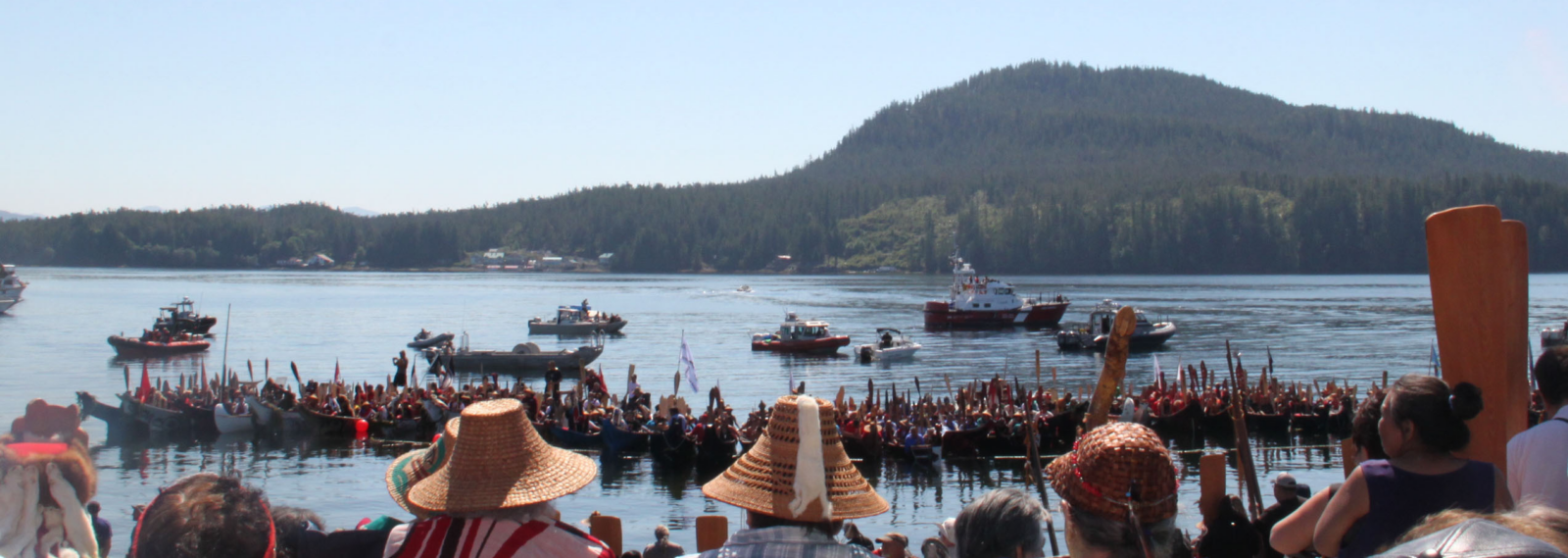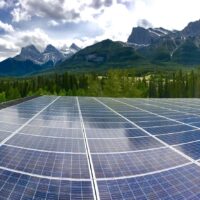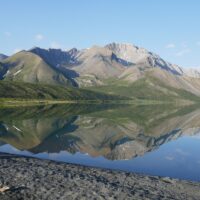This essay was commissioned to inform the research and recommendations in our report Sink or Swim: Transforming Canada’s economy for a global low-carbon future, as part of our Indigenous Perspectives series featuring Indigenous-led initiatives to address and respond to climate change.
In a time of unprecedented crises—including climate change, economic impact, loss of biodiversity, and a global pandemic—we recognize the importance of leadership and collective action to address these crises locally and globally. This essay shares Indigenous insights, concerns, and recommendations to guide the transition to a low-carbon economy. Specifically, it supports establishing Indigenous protected and conserved areas, expanding guardian programs, and building the conservation economy.
Historical and cultural context
Fourteen-thousand-year-old carbon-dated charcoal from a Heiltsuk village campfire located on what is now referred to as Triquet Island in unceded Heiltsuk territory off the Pacific Northwest coast confirms that our people were living on this land many thousands of years before the Roman Empire or the Egyptian pyramids. Our presence was known when the Earth was covered by ice and before the western red cedar migrated up the coast and the salmon populated our rivers, back to a time when sabre-toothed tigers and giant sloths roamed the Pacific Northwest. Our people have borne witness to climate change through deep time. According to this archeological carbon dating, during the first 7,000 years of this vast timescale, our people were harpooning sea mammals, while in the last 7,000 years we were eating more fish, such as salmon and herring.
Our Heiltsuk language also validates this ancient relationship to place. The name of a local marine passage referred to on navigational charts as Nulu Passage originates from the word Nula and in our Heiltsuk language means “eldest sibling.” Nulu Passage is in close proximity to the ancient Heiltsuk village site on Triquet Island. Our language and names also connect us to specific places in our territory and to each other. For example, I have two Heiltsuk names that I received in potlatch ceremonies. The name I carried as a youth, and now share with my grandson, is Athalis, which means “far up in the woods” to commemorate the eight months I spent alone on an island in observance of Heiltsuk ǧvi̓ḷás (laws). It is also the name of a Big House. My Hereditary Chief’s name, λáλíya̓ sila, which means “preparing for the largest potlatch,” was inherited from my late uncle, Robert Hall. λáλíya̓ sila was the first human ancestor who came down at Roscoe Inlet at Clatsja, where he landed on a salmon weir as a half man, half eagle.
Meaningful community engagement is the bedrock of the climate action work currently underway in Heiltsuk homelands. The Heiltsuk have a long history of working together to govern and manage our ecosystem for abundance. For at least 14,000 years, ǧvi̓ḷás (laws) have determined relationships internally, externally, and with the land, waterways, and the spiritual world. Based on principles of respect and balance, this system cultivated abundance through constant change. The last Ice Age and melt were survived by the Heiltsuk because of our strong systems of relationships and values. These same values continue to infuse the work of the Heiltsuk community towards climate action and justice. The latest community engagement of more than three hundred Heiltsuk citizens, held in 2021, demonstrated low conflict and high agreement around transitioning to clean energy. This supportive environment enables the Heiltsuk Climate Action Team to act decisively and coordinate local action on the climate crisis.
Meaningful community engagement is the bedrock of the climate action work currently underway in Heiltsuk homelands.
Heiltsuk Nation’s relationship with nature and the seven fundamental truths
Our Heiltsuk ancestors practised controlled burning of forests, transplanted salmon from salmon-bearing streams to those that did not have salmon, and built clam gardens and fishing weirs to develop a sustainable fishery. This stewardship ethic goes back into deep time when raven transplanted herring from Gildith to Nulu. Throughout our long history of continuous occupation of our territory, our people developed laws and systems of governance that have sustained us through many difficult times. We have been on a journey through time and place that’s depicted in the Heiltsuk’s Sacred Journey initiative, which shares the story of Tribal Canoe Journeys through Indigenous place-based people’s stories, practices, and values—an important example of human resiliency.
In 2009, I served as an Indigenous advisor to Biodiversity BC leading up to the 2010 International Year of Biodiversity. We organized and compiled a report with Heiltsuk, Haida, and ‘Namgis knowledge keepers called Staying the Course, Staying Alive–Coastal First Nations Fundamental Truths: Biodiversity, Stewardship and Sustainability. In this report, we delineated core values, or fundamental truths, that all three coastal native nations subscribe to. These core values are validated through stories, practice, language, and maps. The following seven truths affirm ancient relationships to place and current concepts of biodiversity, stewardship, and sustainability, and provide an important balance for scientific knowledge:
Truth 1: Creation
We, the coastal First Peoples, have been in our respective territories (homelands) since the beginning of time.
Truth 2: Connection to Nature
We are all one. Our lives are interconnected.
Truth 3: Respect
All life has equal value. We acknowledge and respect that all plants and animals have a life force.
Truth 4: Knowledge
Our traditional knowledge of sustainable resource use and management is reflected in our intimate relationship with nature, its predictable seasonal cycles, and indicators of renewal of life and subsistence.
Truth 5: Stewardship
We are stewards of the land and sea from which we live, knowing that our health as a people and our society are intricately tied to the health of the land and waters.
Truth 6: Sharing
We have a responsibility to share and support, to provide strength, and to make others stronger in order for our world to survive.
Truth 7: Adapting to Change
Environmental, demographic, socio-political, and cultural changes have occurred since the Creator placed us in our homelands, and we have continuously adapted to and survived these changes.
The responsibility to care for lands and waters
These fundamental truths have given rise to powerful solutions for addressing climate change and sustaining biodiversity. As Indigenous place-based peoples, we have a sacred responsibility to look after the lands and waters and resources. To achieve our vision of sustainability requires a convergence of local and traditional knowledge, ancestral laws, and the best of what western science has to offer.
For too long, the dominant approach to natural resources has been one of exploitation and exhaustion. But we are connected to the resources that give us life. If we burn through them, we undermine our own futures. Yet if we relate to the natural world in a more thoughtful way, the herring, kelp, salmon, caribou, and moose will remain—not just for us but for generations to come.
To achieve our vision of sustainability requires a convergence of local and traditional knowledge, ancestral laws, and the best of what western science has to offer.
And if we continue relying on carbon-intensive systems, we will not only worsen climate change, but we will endanger the natural systems that sustain us. We have seen the dangerous consequences of these systems firsthand.
On October 13, 2016, for instance, an articulated tug and barge ran aground in Heiltsuk territory. The tug sank and spilled more than 100,000 litres of diesel fuel and 3,700 litres of lube oil, hydraulic oil, gear oil, and spent lubricants into our pristine waters. The vessel operator, who had fallen asleep at the wheel, pleaded guilty, was fined, and funds were set aside to do impact mitigation work. The Heiltsuk currently have a civil suit pending against Canada.
This incident severely impacted our whole community. It was as if a close relative had died. We had to take responsibility for our place through acting as first responders, documenting the first 48 hours, and completing an adjudication report. In the aftermath of the disaster, we plan to establish a Heiltsuk emergency response team and a first responders centre in the central coast of British Columbia. We will also continue expanding the work that maintains healthy lands and waters. This stewardship builds stronger communities and low-carbon prosperity.
Opportunities for Indigenous leadership to improve approaches to development in the Pacific Northwest and boreal region
We have lived in our coastal homeland in relationship with natural resources for millennia. But in recent years, we have seen a sharp decline in ocean resources such as salmon, herring, and Dungeness crabs. Overfishing has taken a toll and so has climate change, creating effects such as big blobs (warm water patches) and higher ocean carbon levels making the water more acidic and altering its chemistry, leading to thinner shells, stunted growth, and premature death in Dungeness crabs.
Heiltsuk Guardian Watchmen track these changes and draw from the expertise of knowledge keepers that has developed over generations. Their research is shaping the Heiltsuk Nation’s decisions about how many crabs can be taken from the water and which areas must be protected to help them recover.
The same pattern is unfolding across the country. There are over 70 Indigenous Guardians programs operating in Canada. Guardians are the eyes and the ears out on the land and the water, and they are helping their Nations respond to climate change. They monitor shifts in the timing of when migratory birds arrive, where caribou find food in winter, when rivers melt in spring, how salmon populations are faring, how drought impacts red cedar, and why wildfires are growing more intense.
Indigenous Guardians are playing a vital role in creating and managing Indigenous Protected and Conserved Areas (IPCAs) across Canada. These areas are critical to Canada’s ability to meet its international climate change and biodiversity commitments, now and in the future.
Indigenous-led conservation is proven to generate sustainable prosperity. Guardians programs offer well-paying jobs that create outsized benefits in small communities—each job supporting family members and purchases in the local economy. IPCAs and Guardians programs also generate new business opportunities and spur investment in regional economies.
Local and traditional knowledge teaches us about long-standing natural systems and processes that have been similar for generations. Climate change disrupts these patterns with erratic shifts in snowpack, ocean chemistry, and timing of seasons.
Indigenous-led conservation is proven to generate sustainable prosperity.
A premise of western research is to establish a baseline. In some cases, western science has between 20 and 80 years worth of data for Northern landscapes. But local Indigenous knowledge is thousands of years old. It is imperative that these two knowledge systems work together to address the climate crisis.
Guardians programs reflect this powerful combination. They join place-based expertise with western tools for measuring water temperature, salinity, permafrost, and other data.
Governments have a role in limiting risks and expanding Indigenous-led opportunities
In many locations, Guardians are the only ones on the land tracking climate change. Crown governments simply don’t have the financial resources to put field stations in remote areas to do this work across the North, but Guardians are already on the ground working in traditional territories. Partnering with Indigenous nations is a fiscally sound approach to helping mitigate climate impacts.
We need the Guardians’ knowledge to inform climate-related policies and decisions, whether it’s setting limits on Dungeness crab harvests or reducing development in carbon-rich lands. Several Indigenous nations, for instance, have proposed creating Indigenous Protected and Conserved Areas in the Boreal Forest. The boreal is the largest remaining intact forest left on the planet, and in Canada alone, it holds about 12 percent of the world’s land-based carbon reserves. Indigenous Protected and Conservated Areas ensure large boreal lands remain undisturbed and prevent enormous amounts of carbon from being released into the atmosphere
Taken together, current proposals would permanently protect well over 20 billion tonnes of carbon—equivalent to almost 100 years of Canada’s annual industrial greenhouse gas emissions.
The work of Guardians benefits not only Indigenous communities, but all of humanity. Guardians draw on thousands of years of relationship with the land to ensure resources that we all depend on—from crab to caribou, clean waters to carbon storehouses—are sustained into the future. As the climate crisis intensifies, it’s time for Canada to support this work. Providing long-term investment in Guardians programs will help Canada honour its climate and conservation commitments and help all of us navigate our changing world.
Opportunities and recommendations
Indigenous communities are inextricable from the environments they are in relationship with, creating a powerful community responsibility to the land, water, and air. It is time Crown governments tapped into the wisdom of this powerful community responsibility through meaningful community-level engagement with Indigenous communities on the climate crisis. The engagement must be solution-focused, community-driven, and well-funded. Indigenous communities must be a driving force behind climate action, not simply have a seat at the table.
It is time Crown governments tapped into this wisdom through meaningful community-level engagement with Indigenous communities on the climate crisis.
The following four areas provide opportunities for collective action:
- Supporting Indigenous-led conservation and stewardship, including Indigenous Guardians. This should be a core part of Canada’s efforts to meet its new commitments to protect 25 per cent of lands and waters by 2025 and 30 per cent by 2030, and should be incorporated in Canada’s post-pandemic economic recovery plan.
- Promoting economic reconciliation, community resilience and prosperity. This includes reimagining what prosperity looks like, addressing economic inequality, and developing new business models that will also help Canada transition to a low-carbon economy.
- Pioneering innovative financing mechanisms and untapped sources to ensure ample resources are available for land and resource management, biodiversity conservation, prosperity, climate resilience, and transition to a low-carbon economy.
- Working with governments to recognize nature-based solutions such as the boreal forest’s ability to capture and store carbon. This includes finding effective ways to create and monetize carbon offsets to provide communities with innovative revenue options for conserving lands and helping Canada meet its biodiversity and climate goals.
Canada is already taking steps towards supporting these efforts, both through the Canada Nature Fund and the National Indigenous Guardians pilot project. These renewed efforts will help us move forward together to create resilient and healthy economies at the local, regional, and national levels, while also helping Canada transition into a low-carbon economy.
Frank Brown is Hereditary Chief and a member of the Heiltsuk Nation from Bella Bella. He is currently an Adjunct Professor at Simon Fraser University, Resource and Environmental Management Department and recently received an Honorary Doctorate of Law from Vancouver Island University.




